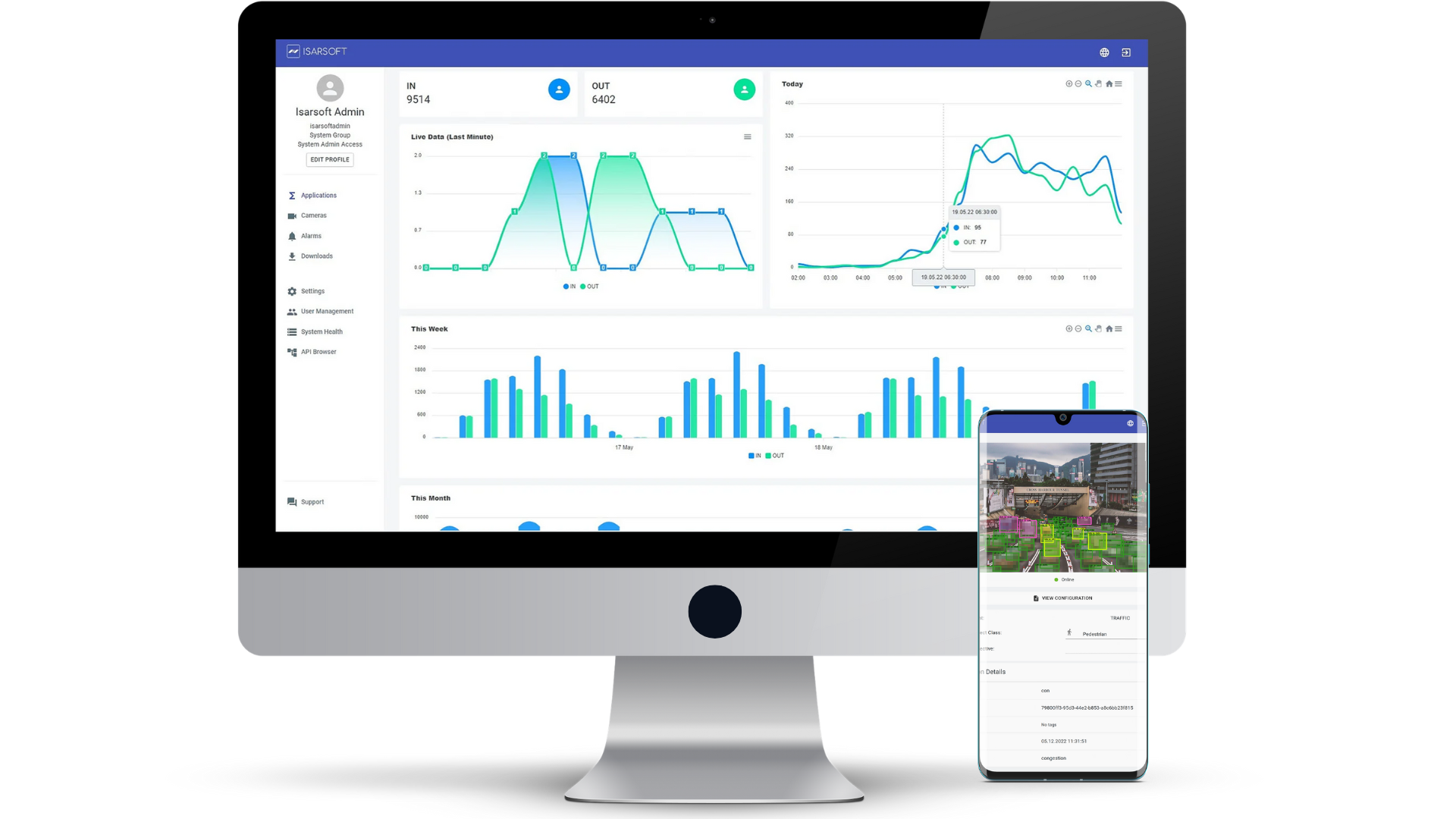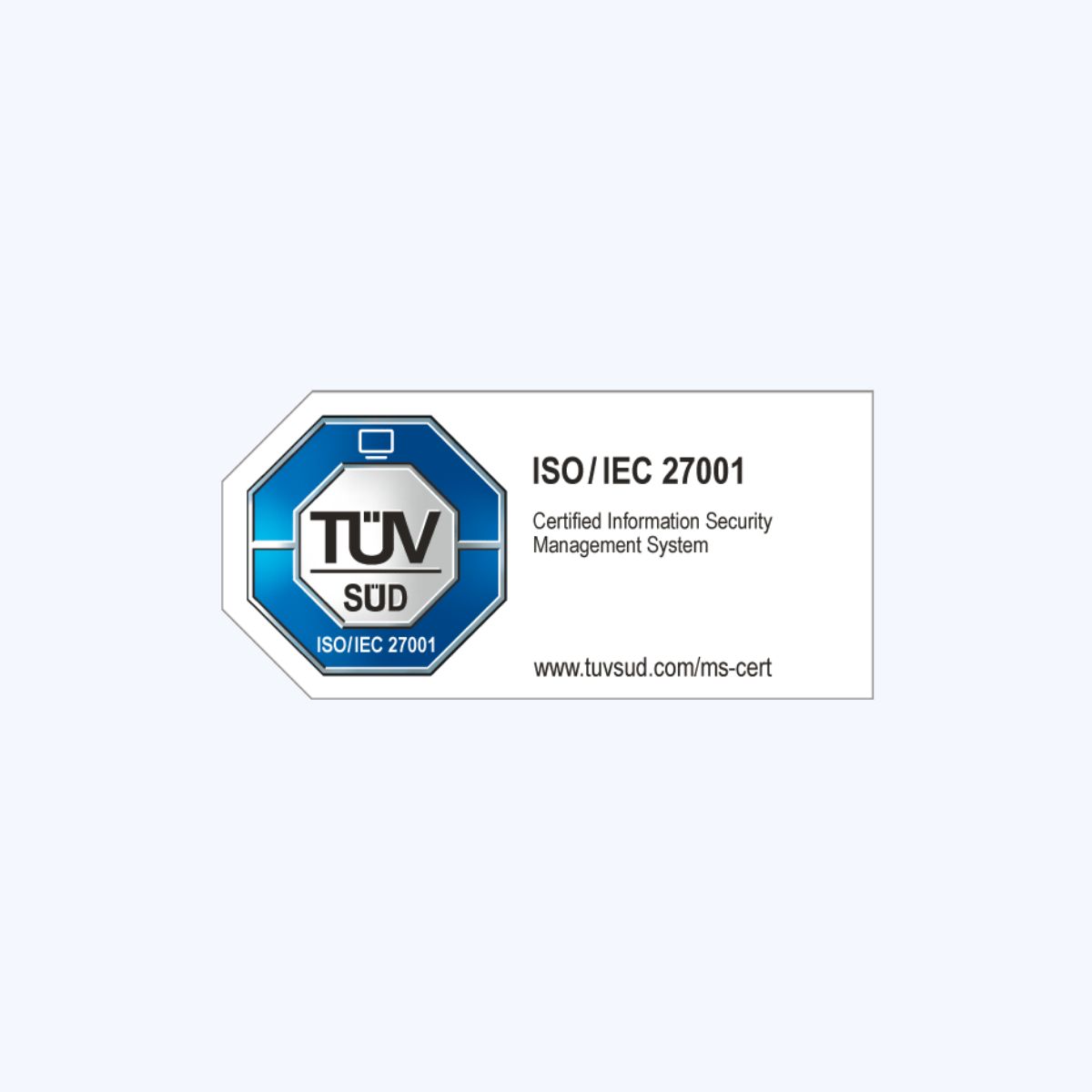Foot Traffic Analytics & Data: The Isarsoft Guide
People counting is not just limited to the counting of people, but also extends to the consequent analysis of footfall to base business decisions on. In this article, we explore the subject thoroughly and examine a specific case to better understand Isarsoft Perception's foot traffic-related features.
Published
July 12, 2023

What is foot traffic or footfall?
Foot traffic (or footfall) refers to the number of people who enter, pass by, or move within a specific location over time. It is a key metric in retail, transportation hubs, and public spaces, helping organizations understand visitor flow, optimize operations, and improve decision-making.
With AI-powered people counting solutions, foot traffic data can be captured accurately and in real time. These systems use video analytics and sensors to:
- Track the number of visitors.
- Analyze movement patterns and dwell times.
- Support resource allocation, staffing, and safety.
- Generate actionable insights for business and urban planning.
In short, foot traffic = people flow data, and modern AI-based people counting makes it measurable, reliable, and actionable.

How to Measure Footfall
The measurement of foot traffic is a process involving a few different steps. In order to accurately measure footfall, the following steps should be followed.
- Set clear goals - The measurement of foot traffic should be done only after setting clear objectives that facilitate the collection of the ‘right’ data. For example, if a retail store owner wishes to analyze the afternoon crowd in his store for a month, he should only be collecting foot traffic data in a specific time frame.
- Choose a collection tool - Foot traffic can be measured using footfall counters. Footfall counters are devices built specifically to count people, and in the case of some, conduct relevant analytics functions. There is a wide range of footfall counters to choose from, each of which employ a different set of technologies. The choice of counter can be made based on requirements and preferences. Some options include security cameras with video analytics, motion sensors installed at entry and exit points, and WiFi/Bluetooth tracking.
- Collect data - The collection of footfall data is done in most cases without the need for any manual intervention, unless there is maintenance or repair work involved. With video analytics tools such as Isarsoft Perception, data is collected 24*7, processed and analyzed - in a highly accurate and precise manner.
- Data Analysis - The analysis of collected data is possibly the most important step in the measurement of footfall. This is because effective analysis reveals valuable insights that are important to drive business performance. Footfall-related data can be analyzed via heat and trajectory maps, lines and zones configured for people counting, and speed and location tracking via georeferencing.

Technologies for Foot Traffic Measurement
There are a lot of existing technologies in the market for people counting. The following list explains them briefly. Door counters are a commonly used method of implementing the following tech.
Manual Clicker
A manual clicker is a piece of mechanical equipment that has to be updated by pressing a button in order to keep a running tally of people counting. It can also be done digitally via a mobile app designed for the purpose.
However, since the core component here is the human element recording the observations- this process is largely considered outmoded in comparison to newer, simpler technologies.
Electronic People Counter
A people counter is an electronic device that can be used to measure the number of people traversing a particular space/entrance/exit. The technology in use here can vary; sometimes light beams are used, while at others there are complicated dedicated sensors such as stereo cameras, time sensors or flight sensors.
Smart Flooring Technologies
Smart floor technologies designed for people counting do so by means of sensors that register contact when stepped on.
Thermal Sensing
Thermal sensors are trained to count people by detection of body temperature. They are generally installed, top-down, at entrances or exit points to enhance accuracy.

Thermal sensing is, however, conditional. It is prone to being negatively affected by sunlight since sunlight radiates the whole light spectrum.
Active Infrared
Also known as break-beam sensors, these sensors have an infrared emitter and an infrared receiver. Standard Active Infrareds count the number of times the beam is ‘broken’. The final figure is then divided by 2.
Most AIRs are bidirectional and are typically installed on one or both sides of a doorway.
WiFi Tracking
This particular technology is functional only if your phone is logged onto the area’s WiFi network when you enter it. All you need to do is have your WiFi turned on.
This technology is not very accurate when it comes to detection at a room level. It also errs on the side of invasive, and so is not favored universally.
Camera-based counting
Camera-based counting systems use cameras to detect objects.
Key Metrics in Foot Traffic Analytics
- Total foot traffic - Total foot traffic is a metric that is used to determine the total number of people who enter a specific area (for example a retail store) within a predefined period of time. This could be a day, a week, or a month.
- Conversion rate - A conversion rate figure is the percentage of visitors in a store who make a purchase. It is a key performance indicator (KPI) that helps retailers measure the effectiveness of their brick-and-mortar stores in converting potential customers into paying ones. A higher conversion rate indicates that the store is successful in attracting and engaging customers, and is likely to generate more revenue.
- Dwell time - Dwell time goes hand in hand with the analysis of foot traffic and is a commonly used term in the field of retail or transportation referring to the amount of time an individual spends in a specific location or area. Dwell time reveals valuable insights into human behavior and can help business owners understand the efficacy of factors like infrastructure, product placement, and space utilization.
- Bounce rate - Bounce rate is a term meant to denote visitors who enter the specified location, take no action, and leave after spending a short amount of time in the area. By assessing the bounce rate, businesses can identify and detect problems and come up with ways to minimize it. For example, if a certain section of the demographic has higher bounce rates, it is an indication that the product/service is not efficiently targeted towards them.
- Repeat visitors - The regular assessment of foot traffic is a good way to identify the number of repeat visitors, i.e. the people who visit the same store again and again. Repeat visitors are good assessors of business performance, and can help users figure out ways to enhance and sustain customer relationships.
Analysis of Foot Traffic Data
Identification of peak hours and days
The identification of peak hours and days is important for business owners in order to maximize brand awareness, sales, and customer engagement. If a specific area or location is most commonly frequented by visitors during a certain window of time or on a particular day of the week, then marketing activities can be concentrated during that span of time to garner maximum organic visibility and traffic.
Identification of popular areas
When assessing footfall in an area, there are certain parts that emerge as hotspots. A hotspot is meant to indicate an area with increased activity, and is a signifier of popularity. Already popular areas can be enhanced to act as eye-catchers and draw crowds in. This would improve sales, as well as general brand perception.

Comparing foot traffic across multiple locations
Only applicable for businesses that exist in multiple locations, a compare and contrast can be helpful in identifying what is working and what isn’t. If one branch of a store does significantly better than its counterparts in other locations, there must be some reason as to why.
Tracking the effectiveness of marketing campaigns
The effectiveness of marketing campaigns can be assessed by the measurement of footfall, and vice versa. The reason for this? Marketing campaigns are designed to attract traffic. When footfall levels increase, it signifies that the core objective of the campaign has been fulfilled.
How does Foot Traffic Data impact Retail?
The retail sector has a close relationship with foot traffic analysis. The reason: footfall is a primary indicator of business performance, and can be used to provide direction to business decisions.
There are many ways in which foot traffic analytics can be utilized in order to garner insights about the business, generate leads, and drive sales.
Video Analytics using Security Cameras
The implementation of video analytics via security cameras is one of the most effective and efficient ways to measure footfall in the retail domain. This is owing to the fact that most retail outfits already have an existing security camera system. The installation of an analytics tool is thereby made cost-effective, time-efficient, and quite naturally the logical choice.
Retail presents a large scope of application to the implementation of video analytics and can be categorized according to the type of retail outfit to be analyzed. This is done on the basis of a number of factors - size, layout, number of employees, technicalities of space, and foot traffic based on predictive analysis and historical data.
Supermarkets, for example, typically consist of one large room broken down into section aisles, or several smaller rooms interconnected through a series of doors. Malls, on the other hand, are generally structures with multiple floors. Each floor has several individual outlets, open spaces, elevators, and escalators. There are also multiple entry and exit points on each level, a parking structure, and open plan dining areas.
Foot traffic figures can be derived from other retail KPIs, just as footfall measurement can be used to garner relevant insights in interconnected domains. Here are a few of them.
.jpg)
Customer Retention
Customer retention refers to the ability of a business to retain its customers, generally over a specific period of time. This KPI is an indicator of factors such as customer loyalty, the concerned business’ superiority over competitors, and the effectiveness of marketing and sales efforts being made.
Customer retention is one of the key ways to induce relationship building, and is strongly interlinked with customer satisfaction.
The measurement and analysis of footfall is how customer retention can be gauged accurately - over a month, quarter, or year.
Customer Loyalty
As briefly highlighted in our last point, customer retention is the consequence of customer loyalty. Customer loyalty refers to the ongoing and favorable relationship between a customer and a business, where the customer demonstrates repeat purchases, positive word-of-mouth, and a strong emotional connection to the brand.
Customer loyalty can be enhanced by businesses providing personalized customer services, exciting value propositions, and satisfying experiences.
Measuring footfall can be used to maximize customer loyalty. The data collected contains customer intelligence (behavioral patterns, buying habits) and can be used to concentrate efforts in a targeted way.
Customer Intelligence
Customer intelligence refers to the process of gathering and analyzing information about customers to discover meaningful insights into their pain points, preferences, buying patterns, etc.

By the measurement of footfall and its consequent analysis, business owners can identify patterns and trends, anticipate customer needs, and create personalized marketing strategies that resonate with their target audience.
Operational Efficiency
One of the primary reasons as to why footfall is measured inside retail stores (a dedicated store traffic counter is often used) is because having a count of the number of people in it at all times works wonders for optimizing operational processes.
This includes a myriad of different functions - the deployment of staff and their placement on the store floor, queue management at the cash registers, deciding how many registers should be operational depending on the occupancy, etc.
Security
Footfall measurement can be used to tighten security, by ensuring that personnel have an accurate overview of store occupancy and are able to monitor any safety-critical incidents that may arise.
This also holds true for loss prevention, i.e. operational errors, internal theft, and external theft.
Video Tutorial
This video depicts the inside of a retail store where video analytics are being used to measure footfall and assess customer engagement.
Future Trends in Foot Traffic Analytics
- AI and Machine Learning Applications - The use of AI to simplify processes is being increasingly used in the urban planning and traffic management domains. The same principles apply to the area of foot traffic, where AI can be used to easily and accurately measure footfall, identify high-traffic areas within a store, transport hub, or public spot, and detect anomalies to enhance general security standards.
- Integration with smart devices - The future of footfall measurement is set to be ‘smarter’, with latest developments such as 5G internet, a growing awareness of IoT, and the ability to integrate foot traffic tech with smart devices to allow widespread access.
- Predictive analytics - Predictive analytics is a form of business analytics that applies machine learning to generate a predictive model for a particular proposition or function. The application of predictive analytics in the arena of footfall is primed to be game-changing - with the ability to anticipate future events and trends, safety and reliability will both be reinforced.
More about Isarsoft
With Isarsoft Perception, your camera systems become part of your business intelligence. Whether the goal is to increase efficiency, customer satisfaction or safety, Isarsoft Perception provides the insights needed for informed decisions.

Contact us, to learn more about how to turn security cameras into intelligent sensors.



